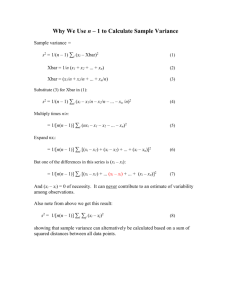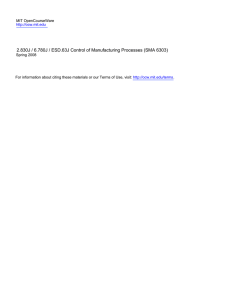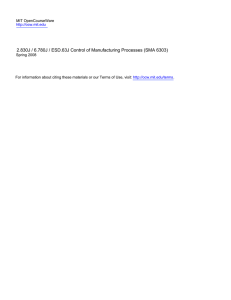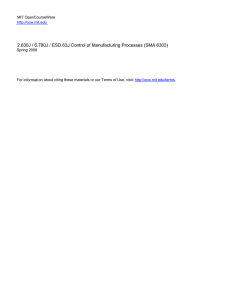2.830J / 6.780J / ESD.63J Control of Manufacturing Processes (SMA... MIT OpenCourseWare rials or our Terms of Use, visit: .
advertisement
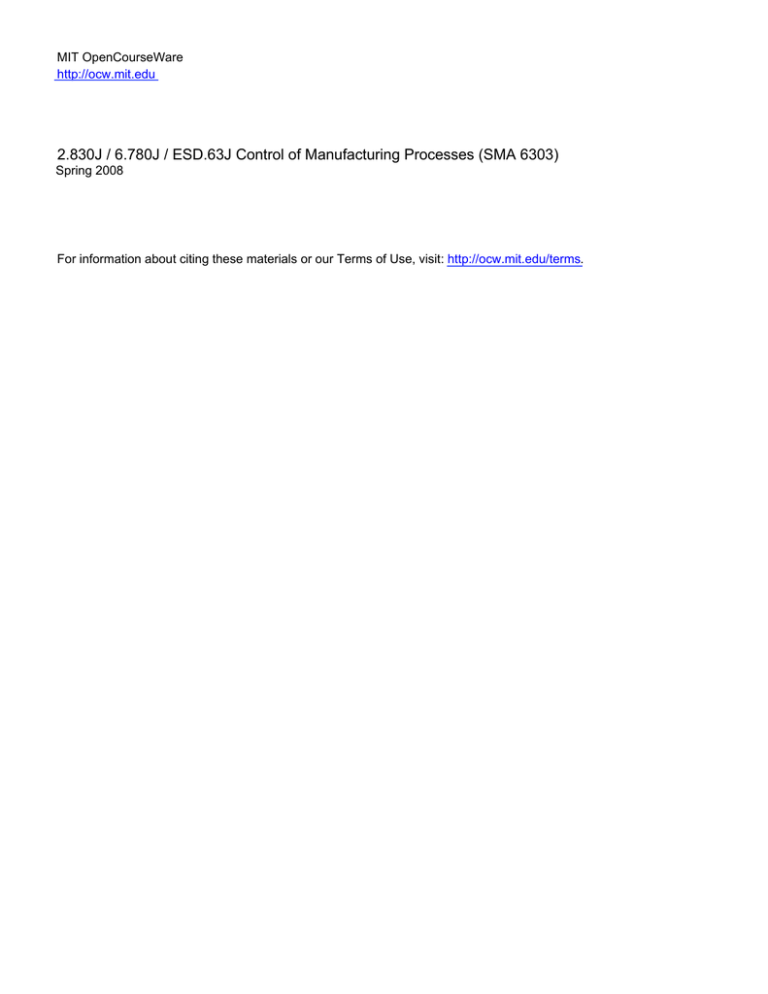
MIT OpenCourseWare http://ocw.mit.edu 2.830J / 6.780J / ESD.63J Control of Manufacturing Processes (SMA 6303) Spring 2008 For information about citing these materials or our Terms of Use, visit: http://ocw.mit.edu/terms. Quiz #1 Solution March 14, 2007 Massachusetts Institute of Technology Department of Mechanical Engineering 2.830J/6.780J Control of Manufacturing Processes Quiz 1 March 20, 2007 Open Book and Notes PROBLEM #1 DESIGN OF A CONTROL CHART BASED ON α AND β ((40%) You have been asked to design a particular type of xbar chart. It is intended only to detect a mean shift of the amount Δ from the grand mean. Instead of the traditional 3 σ limits, you instead are asked to do the following: • • • • Assume the expected mean value of the process is 15 Assume that the parent distribution for the process has a variance of 9 The desired probability of missing a mean shift of +5 is 0.025 (Type I error) The desired probability of signaling a mean shift of +5 when it has not really occurred is 0.1 (Type II error) You are plotting a conventional Shewhart xbar chart, but the goal is to determine the maximum value of n that will meet these specs. a) First sketch out the solution to this problem graphically using normal distributions on a common horizontal axis. Be sure to label all the key variables you will need for the solution. b) What is the minimum number off samples (n) that we must include in xbar to meet these specs? c) Where will the limits be place on the xbar chart? NB: You will need to use the Standard Normal Distribution table (Appendix II) to answer this question. Quiz #1 Solution March 14, 2007 Problem 2 (35%) A manufacturing process output is assumed to follow a normal distribution with mean value μ and standard deviation σ. The specifications for the process are in terms of a dimension and given as 300 + 0.05 mm. From this the process capability indexes Cp and Cpk are computed and found to be 1.2 and 0.9. a) What are μ and σ for the process? b) What are the fraction out of spec. parts that are expected? c) If we had an SPC chart for this process, and the sample size n=5, what would be the values for the centerline and UCL, LCL? d) Sketch the process distribution and the design specifications showing (approximately) the mean – design target and limit relationships. e) If an out of spec part must be reworked at a cost of S$ 20.00, what is the expected quality loss of this process? After some time, it is found that although measurement data confirms the estimates of μ and σ, the number of reject parts far exceeds the expected number. You suspect this is because the process is not following a normal distribution, but some other p(x). As a first guess, you assume it is a uniform distribution with the same observed μ and σ as above. f) If that is true, how many reject parts should be observed? Quiz #1 Solution March 14, 2007 Problem #3 (25%) SPC for Short Production SPC is best applied to repetitive production, where we can develop an accurate set of statistics for the process and then look for how stationary the statistics remain. However, there are many situations where the process produces very few identical parts. One example is a machining job shop where every part made could be different. Over all these parts, the dimensions and material types can very widely It has been proposed to measure each part and plot the error based on the target dimension instead of plotting the dimension itself. In this way a run chart can be created plotting error instead of the absolute dimension or it’s sequential average (xbar) a) How would you create an xbar (in this case an (“ebar”) chart for this data? What would be the centerline and UCL LCL? b) Why would this approach violate the basic assumptions of Shewhart? c) How will the chart vary from a “proper” Shewhart chart in both the limits and the appearance of the data on the chart? d) What would a Cpk value for this process mean?
